Aquatic Matters
Rain, Rain Go Away; And It Did
Now that this spring’s incessant rains have stopped, we can settle in for dry weather. I hope.
Yes, I should be careful about what I hope for, but plants and people generally enjoy clear, blue, skies. For plants, those days mean plenty of light — actually, more than enough, but no harm done — for photosynthesis, which translates to better flavored fruits and vegetables, and conditions inimical to fungal diseases.
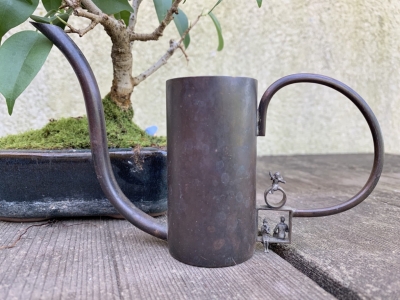 A plant only benefits under these conditions, of course, if it also has enough water at its roots. To that effect, yesterday, in celebration of the second clear, sunny day, I turned on and checked out the drip irrigation system that provides that water to my vegetable plants and blueberry bushes. (With mulches and choice of appropriate plants, all other plants are on their own.)
A plant only benefits under these conditions, of course, if it also has enough water at its roots. To that effect, yesterday, in celebration of the second clear, sunny day, I turned on and checked out the drip irrigation system that provides that water to my vegetable plants and blueberry bushes. (With mulches and choice of appropriate plants, all other plants are on their own.)
Despite the drip irrigation and self-sufficiency of other plants, some hand watering is called for. Trees and shrubs, their first year in the ground, for instance. Also, newly set out vegetable or flower transplants need assistance until their new roots reach a wetting front. The wetting front gets deeper and deeper as a soil dries out. Even with drip irrigation, the wetting front recedes from the ground’s surface with distance from each drip emitter, taking on the shape of overlapping ice cream cones in the soil with their high points right at the surface where an emitter is dripping water. Newly planted seeds likewise need aquatic assistance until they sprout and their roots dip into the wetting front.
A Good Can Is . . .
A hose and a hose wand is one way to get water to needy plants, but for places where it’s not worth the trouble of dragging a hose, a good watering can is just the ticket. You think that a watering can is a watering can? Not so. A quick browse through the web reveals a slew of watering cans differing in style and, hence, ease of use. I’ve tried out a few over the years and, of course, have my favorites.
Size matters. I want a watering can that’s large enough so incessant re-filling isn’t needed for its typical jobs, but not so large as to be unwieldy when filled with water, which weighs in at over 8 pounds per gallon. For houseplants and occasional light jobs, 1.5 gallons works well for me. For more extensive watering, 2 or 3 gallons. The self-serving recommendation in the ad copy for a 3 gallon watering can suggests, “Buy two for a balanced load.” Actually, not a bad idea.
Next, I look at where water exits. Some, usually houseplant watering cans, have merely a spout. Other eater cans have a rose, with little holes for the exiting water. 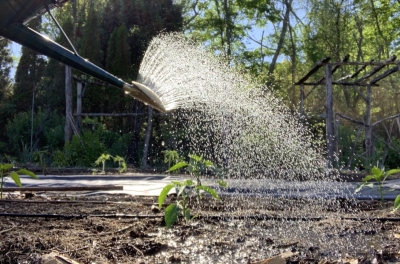 Especially for watering seed flats and small seedlings, a rose needs to be gentle enough to release water sufficiently fast without washing soil around or crushing small plants.
Especially for watering seed flats and small seedlings, a rose needs to be gentle enough to release water sufficiently fast without washing soil around or crushing small plants. 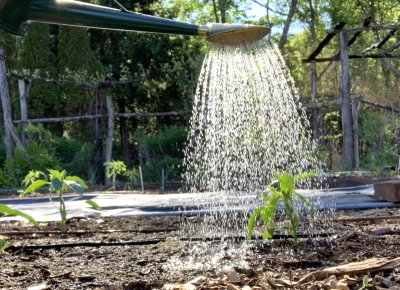 Some debris is bound to find its way into any watering can and thence to the rose, which needs to be removable and easily cleared. Watch out for thin, plastic roses, which are bound to crack after a few cleanings.
Some debris is bound to find its way into any watering can and thence to the rose, which needs to be removable and easily cleared. Watch out for thin, plastic roses, which are bound to crack after a few cleanings.
Speaking of cleaning, I like a can with an opening large enough for me to reach into. Then I’m able to just scoop out a leaf or a twig that found its way inside without waiting for its journey to the rose. Too big an opening, though, and water splashes all over when the can is carries; one watering can that I saw on the web — an open metal can with a spout — takes this to the extreme!
The attachment of a watering can’s handle affects its balance when carried or used. Ideally, you’re not struggling to counterbalance the can in either case.
Finally, there’s the material out of which the can is made. I’m wary of any plastic watering can. Haws has been manufacturing quality watering cans since 1886 but even their plastic watering cans are not worth the plastic they’re made from; I’ve had two that either cracked or leaked. A copper watering can is expensive but will last just about forever.
And the Winners Are (in My Opinion) . . .
As stated, I have some favorite watering cans. Despite what I wrote in the previous paragraph, three of my four favorites are made by Haws. One is the 1.3 gallon, metal can, more specifically the “Bosmere Haws Slimcan Metal Watering Can, Green”. What to say? Nothing more. It has all the characteristics I seek in a watering can of this volume.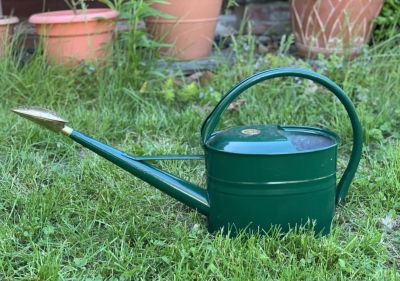
My other two favorites, also Haws, are the same, each with 2 gallon capacity and the same long-reach style and look as the 1.3 gallon Haws. The 2 gallon cans are galvanized, not painted, on their outsides.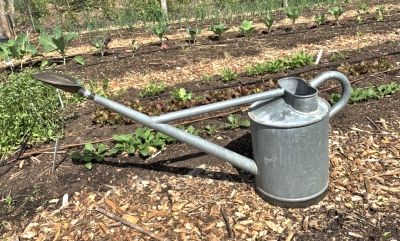
(Galvanized steel does eventually rust. A few years ago, one of my 2 gallon Haws developed pinhole leaks. I’m not complaining; the cans are 30+ years old. I reached inside and dripped some Gorilla Glue, which is waterproof and spreads as it dries, over the holes. That repair is still good after 5+ years!)
Up above, I dissed plastic watering cans — yet another of my favorites is a plastic can, a 3 gallon “French Blue Watering Can”. This one is a thick plastic that seems very crack resistant. It also fills the bill in other ways, especially its balance, which is especially important when I’m wielding a can that can hold 24 pounds of water.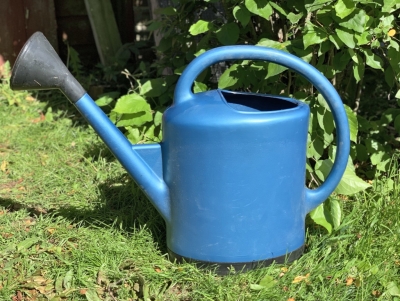
One More
Oh, there’s one more watering can that I really like. It’s more like a watering jar than a watering can, with a capacity of about 1/2 cup. It was purchased at a craft fair. And it is copper. I use it to water my bonsai. Mostly, though, I like to look at it.

